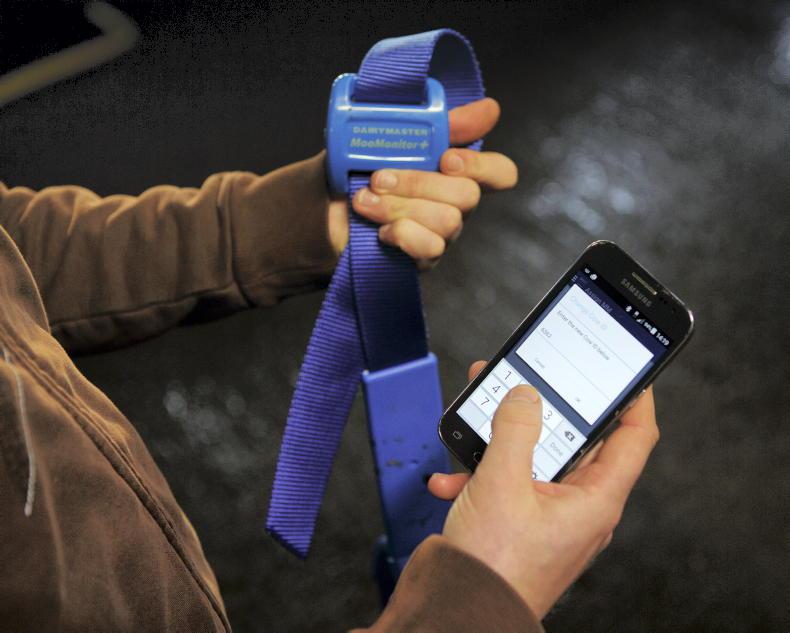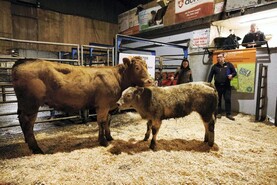One of the greatest barriers to suckler farmers using AI on their herd is heat detection.
The dairy industry in Ireland sees over 60% of calves born to AI bulls, with only about 20% of suckler births attributed to AI.
Visual signs
The suckling of calves on beef cows is generally thought as leading to poorer visual signs of heat compared to the dairy counterparts, which makes heat detection aids even more relevant for beef herds aiming to increase AI usage.
Types of heat detection aids
Vasectomised bull
A vasectomised bull is a young, sexually active bull (generally 11 to 18 months old) that has had the tubes that carry sperm cut and sealed, thereby making them infertile but still active in searching for cows to mate with.
The vasectomised bull can be fitted with a chin ball harness to identify which cows he has mounted and are in heat, ready for AI. The vasectomy should be completed five to six weeks before the bull is required. For biosecurity reasons, a homebred bull should be used.
Where a bull is brought in to the farm from another herd, the necessary disease precautions (isolation and vaccination) should be taken.
A vasectomised bull is particularly useful towards the end of the breeding season when mounting activity from other cows is low.
Some of the drawbacks in utilising a vasectomised bull are the cost of purchase, cost of vasectomy and the health and safety risks of having a bull on farm.
Tail paint
Tail paint is a cheap and effective means of heat detection and is widely used in dairy herds. The paint should be applied in a narrow strip, 1.5 to two inches wide and approximately nine inches in length along the tail head of the cow. Frequent mounting action from other cows will cause friction and rub the paint away, showing the cow to be in heat.
Where a cow not in heat or showing a weak heat is being mounted by those showing a good heat, then the paint will partially be removed. Cows not showing any heat (anoestrous) will be identifiable by the paint remaining relatively intact.
While tail paint is a cost-effective option, it will require frequent topping up as weather will cause it to wear over time.
Tail paint is dependent on cow mounting action, with an issue being that towards the end of the breeding season (when most cows are in-calf), mounting action is less common and tail paint may be less effective as a result.
Collars/ear tags/boluses
Heat detection can also be done with the use of a mobile monitor worn (tag of collar) or inserted (bolus) into the cows, with information on rumination, standing, lying and walking behaviour all being fed back to a base station and transmitted to a phone or laptop/PC.

The use of cow collars as a heat and health monitoring system has increased rapidly in the past number of years and will be spurred on by them now being eligible for TAMS aid. \ Donal O'Leary
These systems are expensive (costs depending on number of base stations/booster stations required, using tags v collars) but they should be looked at as a long-term investment.
The upshot is that they can also be used as a health detection aid for mastitis, milk fever, etc, with TAMS aid also available to assist farmers with purchasing costs.
Scratch cards
Fixed on the tail head of cows (similar to tail paint) heat detection scratch cards see the friction from mounting rub off the silver coating to reveal a bright-coloured patch underneath.
The scratch card is usually affixed using a glue, with several mountings required to fully remove the silver coating.
Unlike tail paint, scratch cards (once properly fixed) do not need to be replaced or replenished until a heat is recorded, but like tail paint it is dependent on mounting activity which will wane as more and more cows go in-calf.
One of the greatest barriers to suckler farmers using AI on their herd is heat detection.
The dairy industry in Ireland sees over 60% of calves born to AI bulls, with only about 20% of suckler births attributed to AI.
Visual signs
The suckling of calves on beef cows is generally thought as leading to poorer visual signs of heat compared to the dairy counterparts, which makes heat detection aids even more relevant for beef herds aiming to increase AI usage.
Types of heat detection aids
Vasectomised bull
A vasectomised bull is a young, sexually active bull (generally 11 to 18 months old) that has had the tubes that carry sperm cut and sealed, thereby making them infertile but still active in searching for cows to mate with.
The vasectomised bull can be fitted with a chin ball harness to identify which cows he has mounted and are in heat, ready for AI. The vasectomy should be completed five to six weeks before the bull is required. For biosecurity reasons, a homebred bull should be used.
Where a bull is brought in to the farm from another herd, the necessary disease precautions (isolation and vaccination) should be taken.
A vasectomised bull is particularly useful towards the end of the breeding season when mounting activity from other cows is low.
Some of the drawbacks in utilising a vasectomised bull are the cost of purchase, cost of vasectomy and the health and safety risks of having a bull on farm.
Tail paint
Tail paint is a cheap and effective means of heat detection and is widely used in dairy herds. The paint should be applied in a narrow strip, 1.5 to two inches wide and approximately nine inches in length along the tail head of the cow. Frequent mounting action from other cows will cause friction and rub the paint away, showing the cow to be in heat.
Where a cow not in heat or showing a weak heat is being mounted by those showing a good heat, then the paint will partially be removed. Cows not showing any heat (anoestrous) will be identifiable by the paint remaining relatively intact.
While tail paint is a cost-effective option, it will require frequent topping up as weather will cause it to wear over time.
Tail paint is dependent on cow mounting action, with an issue being that towards the end of the breeding season (when most cows are in-calf), mounting action is less common and tail paint may be less effective as a result.
Collars/ear tags/boluses
Heat detection can also be done with the use of a mobile monitor worn (tag of collar) or inserted (bolus) into the cows, with information on rumination, standing, lying and walking behaviour all being fed back to a base station and transmitted to a phone or laptop/PC.

The use of cow collars as a heat and health monitoring system has increased rapidly in the past number of years and will be spurred on by them now being eligible for TAMS aid. \ Donal O'Leary
These systems are expensive (costs depending on number of base stations/booster stations required, using tags v collars) but they should be looked at as a long-term investment.
The upshot is that they can also be used as a health detection aid for mastitis, milk fever, etc, with TAMS aid also available to assist farmers with purchasing costs.
Scratch cards
Fixed on the tail head of cows (similar to tail paint) heat detection scratch cards see the friction from mounting rub off the silver coating to reveal a bright-coloured patch underneath.
The scratch card is usually affixed using a glue, with several mountings required to fully remove the silver coating.
Unlike tail paint, scratch cards (once properly fixed) do not need to be replaced or replenished until a heat is recorded, but like tail paint it is dependent on mounting activity which will wane as more and more cows go in-calf.







 This is a subscriber-only article
This is a subscriber-only article










SHARING OPTIONS: